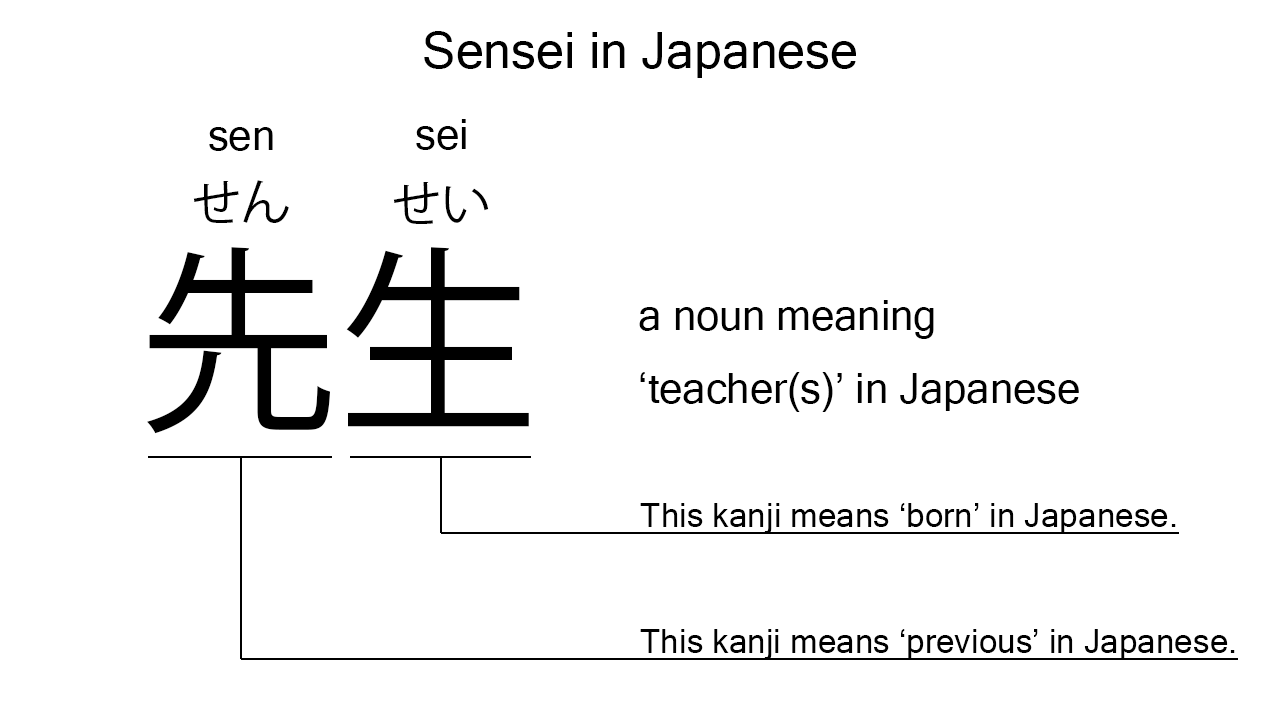What does “sensei” mean in Japanese?
There are some homophones, but native speakers say sensei normally to mean a ‘teacher’ in Japanese. Probably, many Japanese learners know this word as it is often used in Japanese textbooks. In this blog post, however, I will explain this word in detail based on its kanji expression. And also, I will explain how to use it through example sentences. My explanations would help Japanese learners understand sensei more clearly. Then, let’s get started!
Contents
Definition and meaning of “sensei”
Let me start with the definition and meaning of sensei.
- sensei – 先生 (せんせい) : a noun meaning a ‘teacher’ in Japanese. This can also work as plural. Learn more about Japanese plural.
The definition and meaning are simple and clear. To understand this noun more clearly, however, let me explain its kanji characters in detail, one by one.
Sensei in kanji
The kanji expression of sensei consists of the following two kanji characters:
- 先 : a kanji character used to mean ‘before’, ‘earlier’, ‘previous’, or such in Japanese.
- 生 : a kanji character used to mean ‘birth’, ‘born’, ‘life’, or such in Japanese.
These two kanji characters tell us that sensei literally means ‘previously born’ in Japanese. This literal interpretation is not completely in line with the actual meaning, but still understandable, I think. Teachers are often born earlier than students. In addition, this kanji expression implies the fact that sensei can refer not only to teachers in school, but to mentors outside as well.

When we meet new kanji expressions, we should check their kanji characters in detail to understand their meanings clearly and deeply. In many cases, kanji characters tell us a lot about the meanings of the expressions they form. Actually, here, we could get the better understanding of sensei through the detailed kanji check above.
So far, I’ve explained the definition and meaning of sensei together with its kanji characters. Then, let me explain how to use it through the example sentences below.
How to say “teacher” in Japanese
watashi wa sensei ga suki desu – 私は先生が好きです (わたしはせんせいがすきです)
I like my teacher.
Below are the new words used in the example sentence.
- watashi – 私 (わたし) : a pronoun meaning ‘I’ in Japanese.
- wa – は : a binding particle working as a case marker or topic marker. In the example, this works after watashi to make the subject in the sentence.
- ga – が : a case particle used to make the subject word or the object word in a sentence. In the example, this is used after sensei to make the object in the sentence.
- suki – 好き (すき) : the stem part of the na-adjective, sukina, which means ‘favorite’ in Japanese. Native speakers, however, often use this as an individual word to mean ‘to like’ or ‘to love’ in Japanese. In the example, this is used to mean ‘to like’ in Japanese.
- desu – です : an auxiliary verb used after a noun or adjective to make it polite. Probably, this is well known as a part of Japanese desu form. In the example, this is used after suki to make it sound polite.
This is a typical usage of sensei. In this example, it works together with the case particle, ga, to become the object in the sentence.
Another example of “sensei”
boku wa nihongo no sensei ni nari tai – 僕は日本語の先生になりたい (ぼくはにほんごのせんせいになりたい)
I want to be a Japanese teacher.
Below are the new words used in the example sentence.
- boku – 僕 (ぼく) : a pronoun meaning ‘I’ in Japanese. This is used mainly by boys and young males.
- nihongo – 日本語 (にほんご) : a noun meaning ‘Japanese’ or ‘Japanese language’ in Japanese.
- no – の : a case particle joining two nouns. Normally, the first one can work as a modifier to describe the second. In the example, this works to join nihongo and sensei. The formed phrase literally means a ‘Japanese teacher’ in Japanese.
- ni – に : a case particle used to say what someone or something becomes after a change or action. In the example, this is used after nihongo no sensei to say what the speaker wants to become.
- nari – なり : one conjugation of the verb, naru, which means ‘to become’, ‘to turn’, or just ‘to be’ in Japanese. In the example, it has been conjugated for the better connection with its following word.
- tai – たい : an auxiliary verb used after a verb to make its desire form. In the example, this is used after nari to make its desire form, nari tai, which means ‘to want to be’ in Japanese.
This is another example of sensei. In this example, it works together with nihongo and no to mean a ‘Japanese teacher’ in Japanese. When we want to refer to a teacher or teachers in Japanese, anyway, this noun is always a very good option.
Summary
In this blog post, I’ve explained the definition and meaning of sensei in detail based on its kanji expression. And also, I’ve explained how to use it through the example sentences. Let me summarize them as follows.
- sensei – 先生 (せんせい) : a noun meaning a ‘teacher’ in Japanese. This can also work as plural. These two kanji characters literally mean ‘previously born’ in Japanese. This literal interpretation is not completely in line with the actual meaning, but still understandable, I think. Teachers are often born earlier than students. In addition, this kanji expression implies the fact that sensei can refer not only to teachers in school, but to mentors outside as well.
Hope my explanations are understandable and helpful for Japanese learners.
Leave a Reply